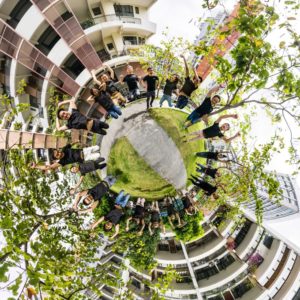There were many things that made the news from Cannes film festival this year, writes Bradley Williams, but one item in particular got a lot of attention; filmmaker Alejandro G. Iñárritu’s Virtual Reality installation titled Carne y Arena. Iñárritu is best known as the award winning director of Oscar successes The Revenant and Birdman, so his delve in to the use of such an emerging technology is bound to make headlines. Carne y Arena was a fully immersive 360-degree sensory experience. It has since been picked up and will be running for several months later this year at the Los Angeles County Museum of Art.
But what does Hollywood’s use of Virtual Reality have to do with its application in the Learning and Development realm? The answer, no surprise, is pretty simple. With Virtual Reality re-defining the world of gaming (Oculus Rift, Playstation VR), making its way in to theme parks (Derren Brown’s Ghost Train, and Seaworld’s Kraken Unleashed), and now becoming a valid form of artistic expression (see Carne y Arena); all signs seems to support the idea that Virtual Reality has finally become a legitimised form of entertainment (Pierce Brosnan’s gaudy techo-thriller Lawnmower Man, is now a thing of distant memory). Even more encouraging though, is the fact that VR will soon be more than just a tool for high-end productions, as the race to make it a consumer led industry has seen the creation of products such as the Sonicam.
The Sonicam, according to its creators Sonirock, is “a user-friendly VR camera that lets the viewer both see and hear everything. It features 9 fisheye cameras for HD 3D video and 64 built-in microphones for ambisonic, 3D Spatial Audio.” OnTrack International recently spent some time with Sonirock to see just how products such as the Sonicam could revolutionise the possibilities of using VR in the world of learning and development.
How did the Sonicam come about?
The idea came from our founder and CTO James Zhan. When he was younger, he lived in a small community in Anhui Province, China. During this time he witnessed a concert on TV and was immediately inspired by the wonderful sounds. At this time he had a desire and a dream to bring the joy of these melodies and sounds to everyone. Since then, after graduating from University, he has dedicated his life to acoustic engineering. He worked in Huawei for 17 years, and then left to create the Sonicam.
Who is the Sonicam aimed at?
The Sonicam is a profession 360-degree 3D VR camera that also features 3D sound. It is aimed at professional filmmakers and VR studios. VR is changing traditional fields, and soon we will see live streams of sports, concerts, news and more; all in VR.
Where do you see the Sonicam being used?
It can be used for many occasions. We are working closely with our customer base to learn how they will use it, and with their help we are discovering its many applications. With their feedback we are working hard to make the Sonicam the ultimate tool for professionals.
In what way could the Sonicam have an impact in the L&D world?
It brings learners a new way to view the world, with the interface being very simple to use. Sonicam captures as much of an experience as possible, and is perfect for companies desiring something different. With the live streaming capabilities as well, it has a lot of applications that can be offered at a very reasonable price.
Many view VR as a gimmick, what do you say to that?
The problem with VR today is that it is only focused on capturing one sense – sight. It disregards sound. Sonicam solves that problem with 360 sound immersion. For some VR might be a gimmick, but not with Sonicam.
How do you see the future of VR developing?
The demand for virtual reality is steadily increasing. By 2020, it is estimated to be a $10 billion industry. Yet, it is impossible for many companies to utilize stunning VR because most of the cameras and service are very expensive, complex and time consuming to create. Furthermore, traditional 360 cameras do not capture sound in the right way. Sonicam is focused on making the ultimate VR camera with ease-of-use functionality and full surround sound. So our hope is that with the Sonicam, companies such as OnTrack can create fully immersive, awesome 360 videos for their clients.
When will it be released?
We are on Kickstarter now (you can find out more here). We have already determined our supply chain and mass production schedule. Our estimated time of delivery will be in October of this year. We will also be launching online sales at that time as well.
 With something as simple as a pair of cardboard goggles, some earphones and a mobile phone, we can be immersed in whatever reality we choose. For businesses, these means sensory experiential training, where staff can be in the moment, learning from staged scenarios without ever having to suffer the indignity of artificial role plays in front of innumerable coworkers, or having to make an uninformed failure in front of the customer. They can have a tangible experience that informs in a way beyond the sharing of information or practice; they can actually experience something. This means we can train pilots; help doctors prepare for surgeries, up-skill front line staff, support trainee police officers and firefighters without the immediate concern of failure. And what’s more, these solutions can be offered for minimal outlay as companies such as OnTrack combine years of learning and development experience with emerging technology such as the Sonicam.
With something as simple as a pair of cardboard goggles, some earphones and a mobile phone, we can be immersed in whatever reality we choose. For businesses, these means sensory experiential training, where staff can be in the moment, learning from staged scenarios without ever having to suffer the indignity of artificial role plays in front of innumerable coworkers, or having to make an uninformed failure in front of the customer. They can have a tangible experience that informs in a way beyond the sharing of information or practice; they can actually experience something. This means we can train pilots; help doctors prepare for surgeries, up-skill front line staff, support trainee police officers and firefighters without the immediate concern of failure. And what’s more, these solutions can be offered for minimal outlay as companies such as OnTrack combine years of learning and development experience with emerging technology such as the Sonicam.
There is a growing desire to separate the terminology used within the VR world, as purists seek to clarify that VR specifically denotes an artificial world which can be traversed and manipulated, where as 360 video is a linear experience with a 360 viewing angle. Then we have interactive 360, and augmented reality as well. But whatever your semantic choice, there is no denying that if applied correctly, VR can be part of a brave new future in the learning environment. Through the use of some simple techniques, and with tools such as the Sonicam, staff could be in a branch, dealing with high-pressure situations, running through techniques and developing soft skills; all within a 360 environment. They could be in the moment, making choices and feeling every instant as if it really mattered. Conferences can be live streamed, allowing absentees the chance to attend and truly feel a part of the proceedings.
Whether from the screen of their desktop computer or the more sensory beneficial method of using cardboard goggles and their mobile phone, staff are now on the precipice of engaging with learning and development in an exciting and emotive world.
EDITOR’S NOTE: OnTrack received no monetary compensation for Sonirock’s involvement with this article. However, we are working closely with them to be able to offer the Sonicam facility in the near future.



